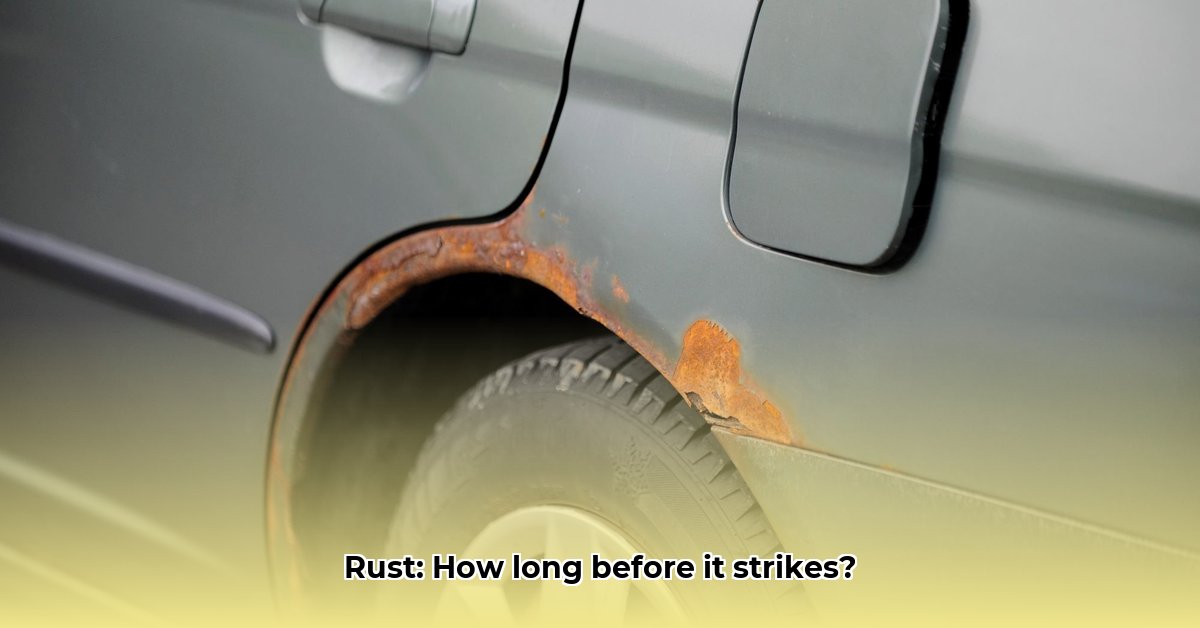
How long does it take for rust to form? The simple answer is: it depends. Rust formation, or corrosion, is a complex process influenced by a multitude of interconnected factors. This guide explores these factors and provides actionable steps for preventing rust in various contexts.
Understanding the Rust Formation Process
Rust, chemically known as iron oxide, forms through a process called oxidation. This occurs when iron reacts with oxygen and water, a reaction that is accelerated by several environmental and material factors. The time it takes for visible rust to appear can range from days to decades.
Environmental Factors: The Recipe for Rust
Several environmental factors significantly influence the speed of rust formation.
- Humidity: High humidity provides the necessary moisture for the oxidation reaction, dramatically accelerating rust formation. A constantly damp environment fosters rapid rusting compared to a dry climate.
- Salinity: Saltwater is highly corrosive, drastically increasing the rate of rust. Coastal structures rust far faster than those inland due to the presence of salt.
- Temperature: Warmer temperatures generally accelerate chemical reactions, including rusting. Higher temperatures, therefore, contribute to faster rust formation.
- Oxygen Availability: Oxygen is a crucial reactant in rust formation. Increased oxygen exposure leads to faster rust development.
Material Properties: The Metal's Role
The type of metal and its condition also play a crucial role:
- Metal Type: Some metals are inherently more resistant to corrosion than others. Stainless steel, due to its alloying elements, exhibits significantly greater rust resistance compared to ordinary carbon steel.
- Surface Area: A larger surface area exposed to the elements increases the rate of rust formation, as there are more sites for the reaction to occur.
- Surface Condition: Scratches, imperfections, and pits on the metal's surface provide more avenues for oxygen and water to initiate the corrosion process, accelerating rust.
The Electrochemical Nature of Rust
The rusting process is fundamentally electrochemical. Electrons flow between different areas of the metal surface, creating anodic and cathodic regions. This process is intensified when dissimilar metals are in contact (galvanic corrosion). The presence of certain chemicals in the surrounding environment can further influence the rate of this electron flow and thereby impact corrosion rates.
Preventing Rust: A Practical Guide
Understanding the factors that promote rust is key to effective prevention. Here's a practical guide for different stakeholders:
For Homeowners: Simple Steps for Rust Prevention
- Regular Cleaning: Regularly wipe down metal objects to remove dirt and moisture that can accelerate corrosion. A dry surface is less susceptible to rust.
- Protective Coatings: Apply paint, wax, or a specialized rust inhibitor to provide a barrier against moisture and oxygen. This offers effective protection.
- Smart Storage: Store tools and equipment in a dry, well-ventilated area. Avoid damp or humid environments.
For Engineers and Manufacturers: Advanced Strategies
- Material Selection: Employ highly corrosion-resistant alloys like stainless steel, especially in harsh environments. This is a proactive measure to mitigate rust.
- Protective Coatings: Utilize robust coatings such as galvanization or powder coating for enhanced protection against corrosion. These increase longevity.
- Design Optimization: Design structures to minimize water accumulation and maximize airflow to reduce the risk of rust formation. Smart design is key to long-term durability.
For Everyone: Early Detection and Intervention
- Regular Inspections: Periodically inspect metal items for any signs of rust, however small. Addressing minor issues promptly prevents escalation.
- Prompt Rust Treatment: Treat minor rust spots immediately using commercial rust removers or home remedies. This prevents the spread of corrosion.
- Rust Inhibitors: Apply rust inhibitor sprays or paints proactively, especially in damp or humid areas. Prevention is far more cost-effective than remediation.
Key Takeaways: The Essence of Rust Prevention
- Predicting rust formation is complex, with numerous interacting factors.
- Marine environments accelerate corrosion due to high salinity and humidity.
- Material selection, protective coatings, and regular maintenance are crucial for rust prevention.
By understanding the science of rust and following these preventative measures, you can significantly extend the lifespan of your metal belongings and avoid costly repairs and replacements. Remember, a proactive approach is the most effective way to fight rust.